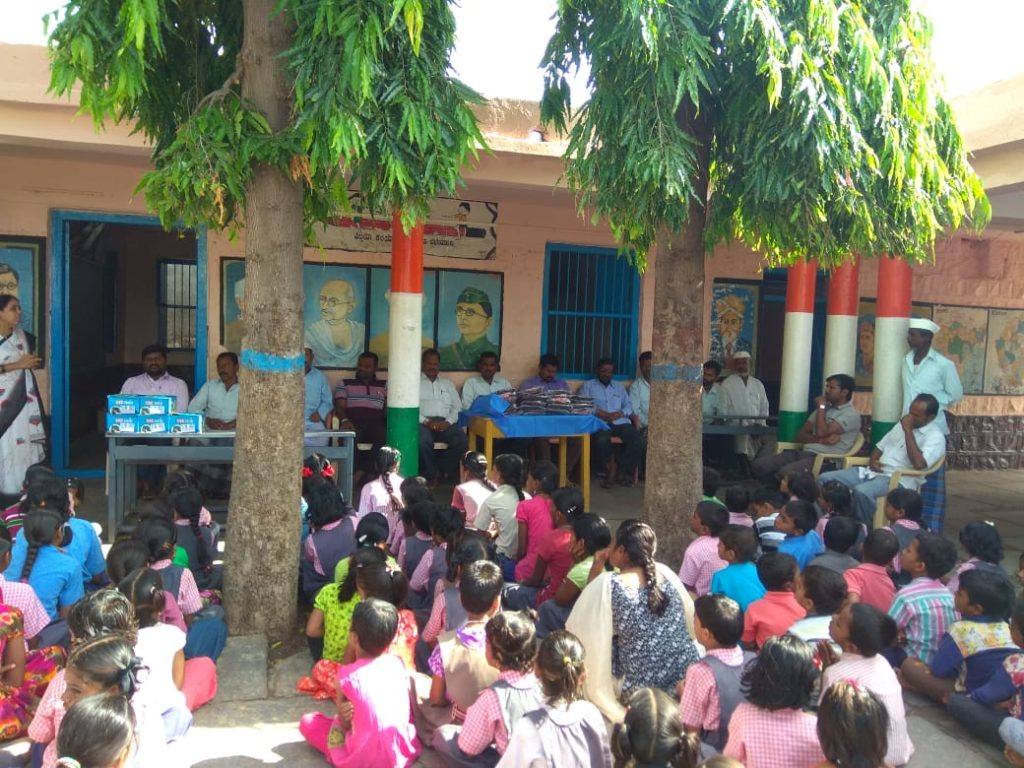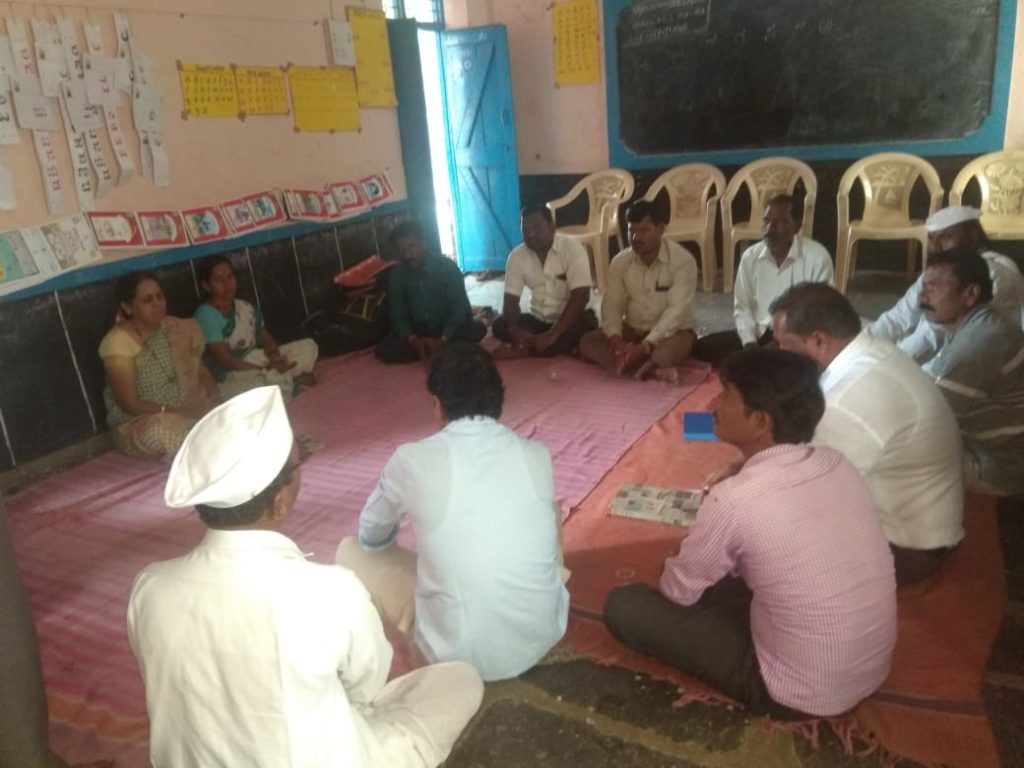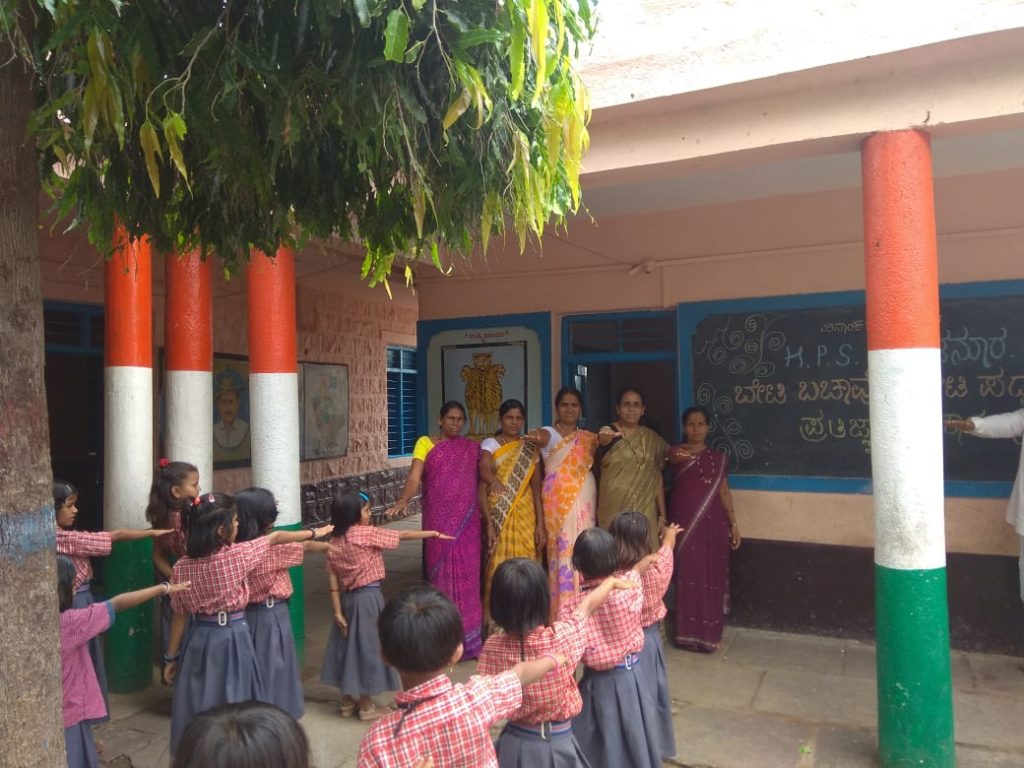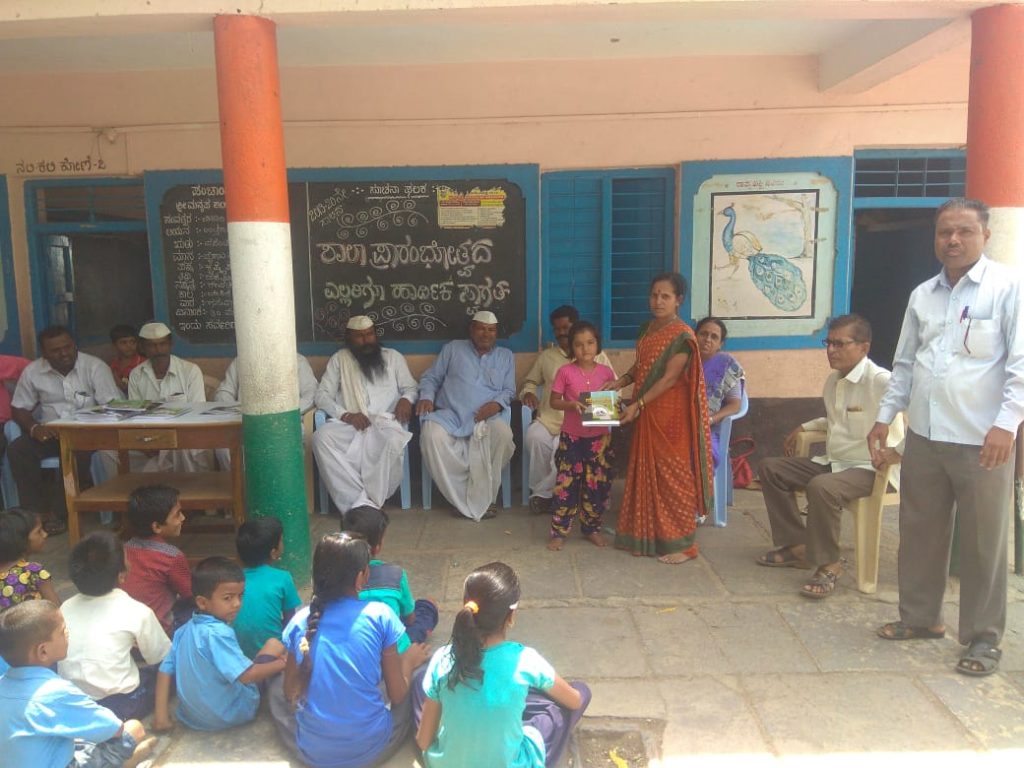Practice Insights > Teachers for Inclusive Society
Extending residential facility to Lamani children
Teacher: Anuja Siddappa Gubba
School: HPS Ambalanur LT, Narasalagi cluster, Basavana Bagewadi block, Vijayapura distict, Karnataka
By: Umashankar Periodi and Sunita S Rao
This article can be read in Kannada here
The School setting
When we entered GHPS Ambalanur, we found all students and teachers engaged in one or the other learning process. There are 165 students studying in this school—79 boys and 86 girls. Including the Head Teacher (HT), there are seven teachers. Every year, at least, four to five students get selected to Morarji, Rashtriya Madhyamik Shiksha Abhiyan (RMSA) or the Navodaya school. Ambalanur is a Lamani Thanda (settlement) with a population of two thousand people. It is situated 12 km from Basavana Bagewadi block of Vijayapur. Most of the villagers migrate to Goa or Maharashtra in search of work every year during October to March. Since most of them find it difficult to leave their children behind, they take them along which leads to the children being out of school for these six months. The teachers worry that these children may lag behind in studies due to this prolonged absence from the school. This has led the teachers and the HT to find some practical solutions to this problem. Some of these solutions through teamwork with the community have led to an improvement in the students’ learning levels. These caught our attention. There are two important strategies which have led to the academic achievements and development:
- Seasonal school (Rutumaana shale) 2013-14
- Team work and transparency
How these strategies were implemented is detailed in the following paragraphs.

Anuja Siddappa Gubba was transferred from Lakshmi Nagar to this school in January 2013. As soon she joined this school, she had to address many challenges. The first was the challenge of tackling the migration of children with their parents and improving their learning levels. Meanwhile, some young people of the village approached her and requested her to reconstitute the School Development and Management Committee (SDMC). Anuja requested for some time to understand the school and the community and assured that the SDMC would be reconstituted in the next academic year.
Challenges before Anuja teacher
GHPS Ambalanur had the problem of inadequate classrooms. Two classes were conducted in the open ground in front of the school. In addition, there was no availability of water in the school. Anuja took on and solved the problems of water supply to the school and of inadequate classrooms. She got a grant sanctioned for the construction of two classrooms. The documents pertaining to the school land were not available and the community opposed the construction of the two new rooms as there was a temple close to the school land. Anuja remained undeterred and identified some donors who donated four gunta land (1 gunta is equivalent to 121 square yards or 101.17 square metres) of their farmland for the construction of the classrooms. In this way, the classrooms were constructed.
Anuja had to also face the problem of the villagers often visiting the school in an inebriated state which had a negative impact on the school, the children and the teachers. With the help of her staff and the support and cooperation of the community, she tackled this. She contacted a physician from Basavana Bagewadi, Dr Ramu Nayak to convince the community members to not visit the school when drunk. Anuja and her staff also had dialogue with the villagers and appealed to them to comply. Initially, some people would still come, but soon, they withdrew. The villagers also stopped spending their evening leisure hours in the school premises. Now, villagers enter the school premises only if they have work related to the school.
Anuja called a parents’ meeting with the objective of reconstituting the SDMC. She sent out a notice to parents requesting them to attend. During the meeting, the objectives of forming the SDMC and their role in it was explained to the parents. The date for reconstituting the SDMC was also finalized. Accordingly, the SDMC was reconstituted to include members who are literate and concerned about the school.

The mid-day meal (MDM) staff of the school, only cooked the food; they neither engaged in any other school work nor bothered to clean up the plates or the surroundings after lunch time. The students often stepped on food spilled on the ground. When Anuja discussed this issue with the MDM staff, they refused to oblige. The wife of the Gram Panchayat head was part of the MDM staff. Repeated attempts failed to convince them, and so Anuja took the brave decision of changing the MDM staff to one that would be free from all ‘politics’. The new MDM staff members have willingly agreed to support the teachers in different ways, for instance, they have taken the responsibility of opening and closing the school every day, provide tea and snacks to guests visiting the school, and cleaning the classrooms and the compound after lunch.
Apart from the above challenges, Anuja’s main challenge was to discourage students from migrating with their parents which affected their learning adversely. She discussed this matter with her staff and they decided to start a ‘seasonal school’. They started it for 50 students and provided them with food and accommodation. Volunteers were arranged to cook food for them and take care of their learning. They took great care to ensure that everything happened as per the plan. This enabled students to engage in learning continuously and the teachers to teach effectively. The students were also provided with medical care when required and they were allowed to communicate with their parents on phone at regular intervals because of which students and their parents remained free from worry.
Starting a seasonal school and assuming the responsibility of the care of 50 students—providing meals, taking care of their health and studies with love and affection, is a challenging task. The HT could not recover the entire expenditure she spent on it but does not regret it. This bold step of Anuja’s also convinced the parents that their children were learning better and now, the migrating parents have started leaving their children behind with their older siblings, grandparents or relatives instead of taking them along to distant places in search of work. This ensures that the children continue their learning uninterrupted. Now the teachers take care of such children and maintain communication with their parents. Thus, the rate of students migrating with their parents has reduced considerably.
After reading the above story, the obvious question that arises in our minds is about the language barrier that must have come between the teachers and these children. The HT and the other teachers never let this become a hurdle. To overcome this challenge, they organized parent-teacher meetings (PTMs) and appealed the parents to cooperate in improving their children’s learning. They asked the parents to converse with their children in Kannada, along with their Lamani language, at home. They sought the support of senior students to improve the learning among the Nali-Kali students. This enabled the teachers to engage the students effectively in the classroom. Gradually, the Lamani language ceased to be a barrier in the teaching-learning process.
Anuja says, ‘People extend cooperation if we are ready to serve them. We wish that these students grow up to become good human beings, good citizens with good qualities and good personality.’ The support from the villagers, who are all laborers, is immense. They extend all possible cooperation to the school. The school or the staff do not expect any monetary help from them.
When Anuja joined the school as HT and decided that the school should be painted, paint worth Rs 20,000 was purchased. The grant for this work was only Rs 17,000. The community members not only contributed money for the paint, but also paid for the labour without bothering the HT. In this way, the community also joined hands with the school staff for work related to the school. Anuja says that the community members believe that, ‘Our thanda school should not lag behind in any way.’

In joining the efforts for the school’s development, the participation of the community is commendable. The impact of the school-community partnership in the overall development of the school and the children’s learning is the evidence. Whenever there is a cluster-level or hobali/taluk-level event, all the villagers spend the entire day helping the school staff. Whenever the school receives any grant from the department, the HT informs the SDMC, staff and community representatives about it and all of them together take the decision regarding the right utilization of the money. In case, the grant is insufficient, the community members come forward to contribute additional funds. For instance, when the grant provided by the government for Pratibha Karanji 1 was insufficient the community members contributed Rs 5,000; each teacher contributed Rs 1,000; and, the HT contributed Rs 2,000.
The SDMC meeting is held every month. Whenever there is a discussion on organizing special programs, grant received from the government or funds required by the school, the villagers and community leaders also participate along with the SDMC. The school responsibilities have been shared among the school staff and the MDM staff according to their individual capabilities. Regular staff meetings are conducted and matters, such as the use of TLMs in the classroom, children’s learning and implementation of the department’s guidelines are discussed and decisions taken.
The School Leadership Development Program (SLDP) has contributed to the development of leadership qualities among HTs. It has inspired HTs to take the lead in every situation and has improved their temperament. It has made the organization of various programs, such as, simple experiments for children (Sarala Prayoga), quiz (Rasa Prashne), book reading (Pustaka Odu), to name a few, in the school, possible.
Anuja says, ‘The development of the school and improvement in the students’ learning levels has been possible only due to the support and cooperation of the villagers, the SDMC, teachers and students and not merely due to the Head Teacher.’ She adds, ‘Recently, the community members have started saying that the school is developing. It is necessary to maintain transparency and work by accepting challenges to achieve more development. After I joined this school, the HT of the school in my native village had expressed his willingness for a mutual transfer so that I can work in my native village. But we have been able to overcome some challenges here, the community is responding positively to the school’s efforts and so I feel it is better to continue here. Now, I have decided that I will not go for a mutual transfer.’
Anuja teacher’s background
Anuja Gubba is the third daughter of Siddappa Gubba who has four daughters and two sons. He is a high school teacher and has not only provided good education to his children but has also inspired them too lead a life of values. Among his six children, three have become doctors and three are in the teaching profession. The three doctors run the Gubba hospital at Basavana Bagewadi. All the children are self-dependent. Anuja’s husband Shrishail Bhimmanna Havinal is a teacher at the New High School, Basavana Bagewadi and has a special interest in agriculture. Anuja has completed her master’s in economics. She was first appointed as a teacher to KBHPS Yaranal where she served from 1989-97. Next, she was posted at the Lower Primary School (LPS) Lakshmi Nagar, Basavana Bagewadi.

The interesting thing to note is that though she was posted to LPS Lakshmi Nagar, the department had only approved the school on paper. There was no specified land or location, no classrooms or children when Anuja joined the ‘school’. She tells us, ‘I used to literally cry. I was happy at being posted to a town, but I used to worry that there was no school, no classrooms and no children. I used to wonder what I am supposed to do. A survey was done, and a school was inaugurated by hiring a rented space. Trying to obtain land for the school alongwith conducting the classes was a struggle. We searched for some places, but they were not appropriate. Then the corporation authorities agreed to provide space for the school near a lake. We were happy to have obtained the land, but it was a difficult terrain full of mud mounds. We had a discussion with the community members and the entire land was levelled using a JCB in a single night.’ The next task was to get the school building constructed. She met the then BEO Mr Mathapati who asked her to write a letter appealing for at least one classroom to be constructed. After further discussions, they felt that one room may not be sufficient, so she appealed for three, and got approval for two, plus one, classrooms. Later, during the tenure of BEO Bathakunaki three rooms were sanctioned. In this way the school which initially had no land, no classrooms and no children, now has its own land, classrooms, children and a campus full of greenery. In January 2013, Anuja was posted to GHPS Ambalanur as HT. There were many challenges in this school too. We can see from the above account how she overcame all of them.
Author
Umashankar Periodi leads Azim Premji Foundation’s work in Karnataka. He has been in the field of development for two decades working with tribal and marginalized sections. He has been with the Foundation since 2003 in different roles.
Sunita S Rao has worked with marginalized people for ten years. She is, at present, leading the Vijayapura team of the Azim Premji Foundation.

